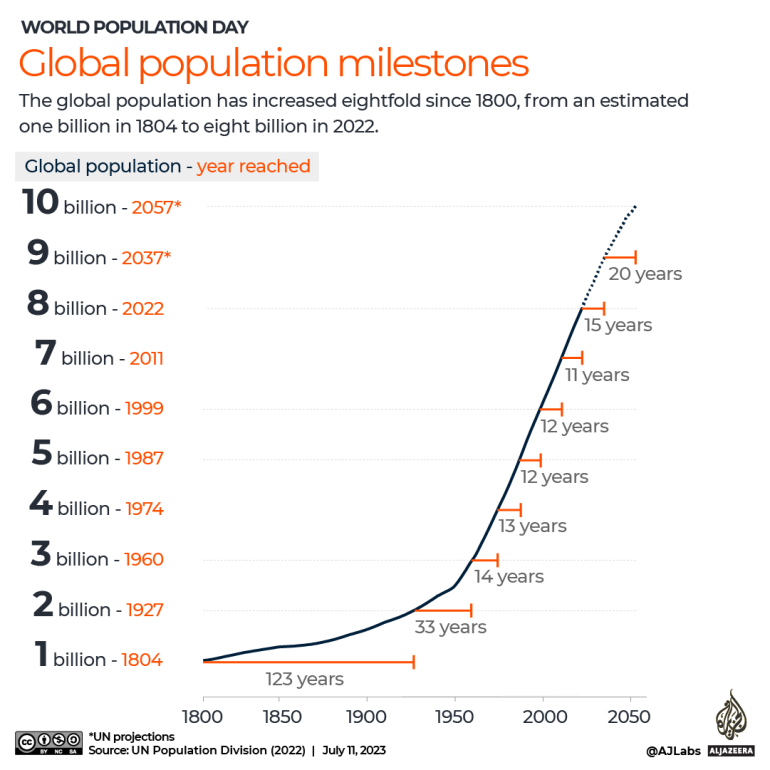World Population Day: What will the world look like in 2050?
Over the past year, the world population officially hit eight billion, and India surpassed China to become the world’s most populous country.

People across the globe observe July 11 as World Population Day – designated by the United Nations to focus attention on the urgency and importance of population issues, including their relations to the environment and human development.
Over the past 12 months, the world saw two significant population milestones. First, in November 2022, the global population officially hit eight billion people. Second, in April this year, India surpassed China to become the world’s most populous country, according to UN estimates.
Keep reading
list of 4 itemsMapping pro-Palestine college campus protests around the world
Satellite images reveal Israeli destruction of hospitals in Gaza
Mapping Israel-Lebanon cross-border attacks
While the world’s population continues to grow, the rate of its growth is actually slowing. Earlier this year, South Korea once again smashed its own record for the world’s lowest fertility rate, while other countries across Asia including Japan and China also recorded their lowest birth rates.
In the following infographic series, Al Jazeera breaks down the world’s population numbers and explains what declining populations mean for the rest of the world.
How the world’s population tripled in 70 years
In 1955, there were 2.8 billion people on Earth. Today, that is the population of India and China alone.
The animation below shows how the world’s population tripled from 2.5 billion people in 1950 to 8 billion in 2022. According to estimates by the United Nations Population Division, the world will reach some 9.7 billion people by 2050.
By 2050, after India and China, Nigeria is expected to become the world’s third most populous nation, followed by the United States, Pakistan, Indonesia, Brazil, the Democratic Republic of the Congo, Ethiopia and Bangladesh, in that order.

Is your country’s population growing or shrinking?
In simple terms, a country’s population can be determined by four factors: births, deaths, immigration (people entering the country), and emigration (people leaving the country).
If the number of births and immigration surpasses the number of deaths and emigration, the population of the country will grow. Conversely, if the opposite occurs, the population will decline.
In 2022, nearly 134 million babies were born around the world. That is an average of 367,000 newborns each day. While this may sound like a lot, it is actually the lowest number of newborns since 2001.
The number of deaths worldwide has also been gradually increasing from less than 50 million before the 1990s to 58 million in 2019. However, during the COVID-19 pandemic, deaths sharply increased. In 2020, 63 million deaths were recorded, followed by a record 69 million in 2021. Approximately 67 million deaths were recorded in 2022, according to estimates.
The net result is a global population that grew by 0.8 percent.
The map below highlights the population growth rate for countries around the world in 2022.
Africa is the fastest-growing continent in the world, with countries including Niger, Uganda, DRC, Angola, Chad, Mali and Somalia each growing at a rate greater than 3 percent per year.
On the flip side, most of the world’s fastest-shrinking populations are located in Europe and East Asia. Low birth rates have prompted governments to roll out a wide range of financial incentives and support to new mothers.
In South Korea, for example, new parents are being offered cash payments of $10,500 in an attempt to fend off a looming demographic and economic disaster.
Shrinking and ageing populations pose huge challenges to labour markets and the economy as a whole.
Alongside a decline in the number of working-age individuals, significant reforms will be necessary to adapt social services and healthcare systems to accommodate increasingly ageing populations.
What is the average age in your country?
A useful metric to understand a country’s population is to look at its median age which represents the age at which half of a given population is older and half is younger.
For the first time in recorded history, the global median age is now above 30 years.
The table below ranks the world’s median age from the oldest to the youngest.
World population’s billion milestones
The global population has increased eightfold since 1800, from an estimated one billion in 1804 to eight billion in 2022. This growth can largely be attributed to the development of modern medicine and the industrialisation of agriculture which boosted global food supplies.

- One billion – 1804
- Two billion – 1927 (took 123 years)
- Three billion – 1960 (took 33 years)
- Four billion – 1974 (took 14 years)
- Five billion – 1987 (took 13 years)
- Six billion – 1999 (took 12 years)
- Seven billion – 2011 (took 12 years)
- Eight billion – 2022 (took 11 years)
- Nine billion – 2037* (UN projections)
- Ten billion – 2057* (UN projections)
While the global population continues to reach new highs, demographic experts have pointed out that the annual growth rate has consistently declined to below 1 percent.
Based on these projections, the world’s population is expected to peak at about 10.4 billion people in the 2080s and remain at that level until 2100.